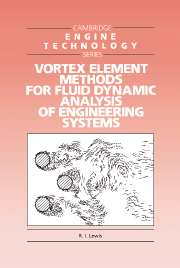Book contents
- Frontmatter
- Contents
- Preface
- Acknowledgements
- Part 1 The surface vorticity method for inviscid ideal fluid flow
- Part 2 Free shear layers, vortex dynamics and vortex cloud analysis
- Chapter 7 Free vorticity shear layers and inverse methods
- Chapter 8 Vortex dynamics in inviscid flows
- Chapter 9 Simulation of viscous diffusion in discrete vortex modelling
- Chapter 10 Vortex cloud modelling by the boundary integral method
- Chapter 11 Further development and applications of vortex cloud modelling to lifting bodies and cascades
- Chapter 12 Use of grid systems in vortex dynamics and meridional flows
- Appendix Computer Programs
- Bibliography
- Index
Chapter 8 - Vortex dynamics in inviscid flows
Published online by Cambridge University Press: 05 November 2009
- Frontmatter
- Contents
- Preface
- Acknowledgements
- Part 1 The surface vorticity method for inviscid ideal fluid flow
- Part 2 Free shear layers, vortex dynamics and vortex cloud analysis
- Chapter 7 Free vorticity shear layers and inverse methods
- Chapter 8 Vortex dynamics in inviscid flows
- Chapter 9 Simulation of viscous diffusion in discrete vortex modelling
- Chapter 10 Vortex cloud modelling by the boundary integral method
- Chapter 11 Further development and applications of vortex cloud modelling to lifting bodies and cascades
- Chapter 12 Use of grid systems in vortex dynamics and meridional flows
- Appendix Computer Programs
- Bibliography
- Index
Summary
Introduction
The early contributors to the surface vorticity method such as Martensen (1959), Jacob & Riegels (1963) and Wilkinson (1967a) were concerned primarily with the development of a flexible numerical method for the solution of potential flows. Preceding chapters testify to the scope and power of this conceptually simple technique and to the imagination and creativity of a host of later research workers who have extended the method to deal with a wide range of engineering potential flow problems. Although the broader physical significance of the surface vorticity model, as expounded in Chapter 1, has always been realised, only recently has this been more fully explored by attempts to model the rotational fluid motion of real fluids including both boundary layer and wake simulations. The remaining chapters will lay down progressively the essential fundamentals of this work which the reader requires to proceed to practical computational schemes, employing what has come to be known as the ‘vortex cloud’ or ‘discrete vortex’ method.
All real flows involve rotational activity developed in the regions adjacent to flow surfaces or in the rear wake region in the case of bluff bodies. Some flows also exhibit spontaneous boundary layer separation or stall behaviour while in other situations flow separation occurs inevitably from sharp corners.
- Type
- Chapter
- Information
- Publisher: Cambridge University PressPrint publication year: 1991



